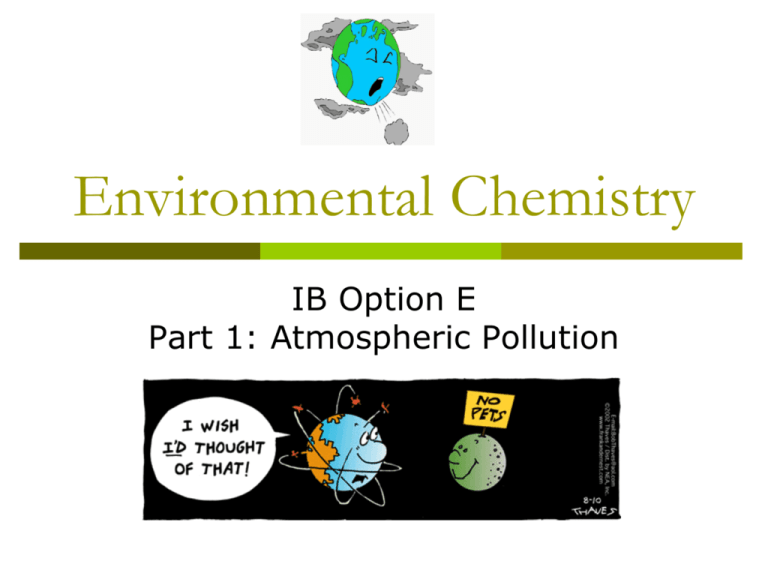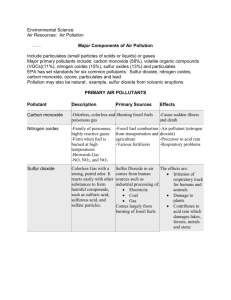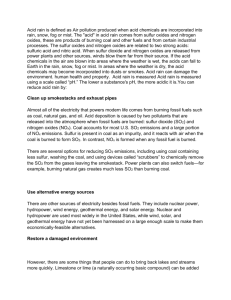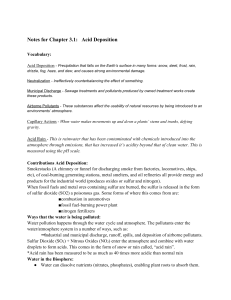Environmental Chemistry
advertisement

Environmental Chemistry IB Option E Part 1: Atmospheric Pollution Unpolluted Air 78% N2 21% O2 1.0% Ar 0.03% CO2 AIR POLLUTION Primary air pollutants – harmful substances released into the air that are not normally present Secondary air pollutants – harmful compounds formed when primary pollutants react in air Carbon monoxide (CO) Natural Source: Incomplete oxidation of methane CH4 + 1½O2 CO + 2H2O Carbon monoxide (CO) Anthropogenic (man-made) Source: Incomplete combustion of fossil fuels Ex: C8H18 + 8½O2 8CO + 9H2O Carbon monoxide (CO) Effect on health: Prevents hemoglobin from carrying oxygen by forming carboxyhemoglobin Carbon monoxide (CO) Methods of reduction: Use of lean burn engine Thermal exhaust reactor Catalytic converter Oxides of nitrogen - NOx Natural Source: Electrical storms and biological processes Oxides of nitrogen - NOx Anthropogenic (man-made) Source: At high temperatures inside internal combustion engines N2 + O2 2NO Oxides of nitrogen - NOx Effect on health: Respiratory irritant leading to respiratory tract infections Oxides of nitrogen - NOx Methods of reduction: Use of lean burn engine Recirculation of exhaust gases Catalytic converter Global air pollution (NASA) Oxides of sulfur - SOx Natural Source: Oxidation of H2S produced by volcanoes Decay of organic matter Oxides of sulfur - SOx Anthropogenic (man-made) Source: Combustion of sulfur-containing coal Smelting of sulfide ores S + O2 SO2 Oxides of sulfur - SOx Effect on health: Respiratory irritant leading to respiratory tract infections Oxides of sulfur - SOx Methods of reduction: Removal of sulfur from fossil fuels before combustion Alkaline scrubbing Fluidized bed combustion Particulates Natural Sources: Soot Ash Dust Asbestos Sand Smoke Pollen Bacterial & fungal spores Particulates Anthropogenic (man-made) Source: Burning of fossil fuels, particularly coal and diesel Particulates Effect on health: Can affect the respiratory system and cause lung diseases, such as emphysema, bronchitis, and cancer Particulates Methods of reduction: Sedimentation chambers Electrostatic precipitation Volatile organic compounds - VOCs Natural Source: Plants (i.e. rice) Many plants emit unsaturated hydrocarbons called terpenes Volatile organic compounds - VOCs Anthropogenic (man-made) Source: Unburned or partially burned gasoline and other fuels Industrial solvents Volatile organic compounds - VOCs Effect on health: Some (i.e. benzene) are carcinogenic. Can form toxic secondary pollutants (i.e. PANs, a.k.a. peroxyacyolnitrates) Volatile organic compounds - VOCs Methods of reduction: Catalytic converter Thermal exhaust reactor Exhaust from the car engine is combined with more air and reacts due to the heat of the exhaust gases. CO is converted into CO2 and unburned hydrocarbons are also combusted. 2CO(g) + O2(g) 2CO2(g) Lean burn engines By adjusting the carburetor the ratio of air:fuel can be altered. The higher the ratio the less CO emitted as more complete combustion occurs. Unfortunately, this produces higher temperatures so more NOx is produced. At lower ratios less NOx but more CO will be emitted. Catalytic converter The hot exhaust gases are passed over a catalyst of platinum, rhodium or palladium. These fully oxidize CO and unburned VOCs, and also catalyze the rxn between CO and NO. 2CO(g) + 2NO(g) 2CO2(g) Alkaline scrubbing & limestonebased fluidized beds Some sulfur is present in coal as metal sulfides (i.e. FeS) and can be physically removed by crushing coal and mixing with water. The more dense sulfides sink to the bottom and the cleaned coal can be skimmed off. Sulfur is also removed from oil before it is refined by converting it into hydrogen sulfide (H2S). Alkaline scrubbing & limestonebased fluidized beds Sulfur dioxide (SO2) can be removed from the exhaust of coal burning plants by “scrubbing” with an alkaline slurry of limestone (CaCO3) and lime (CaO). The resulting sludge is used for landfill or as gypsum (CaSO42H2O) to make plasterboard (drywall). CaCO3(s) + SO2(g) CaSO3(s) + CO2(g) CaO(s) + SO2(g) CaSO3(s) 2CaSO3(s) + O2(g) + 4H2O(g) 2CaSO42H2O(s) Alkaline scrubbing & limestonebased fluidized beds CaCO3(s) + SO2(g) CaSO3(s) + CO2(g) CaO(s) + SO2(g) CaSO3(s) 2CaSO3(s) + O2(g) + 4H2O(g) 2CaSO42H2O(s) Wet alkaline scrubber Wet scrubber Alkaline scrubbing & limestonebased fluidized beds A more modern method known as fluidized bed combustion involves burning the coal on a bed of limestone which removes the sulfur as CaSO3 or CaSO4 as the coal burns. Electrostatic precipitation Particulates are solid or liquid particles suspended in the air. Larger particles can be allowed to settle under the influence of gravity in sedimentation chambers. For smaller particles, an electrostatic precipitation chamber can be used. The charged particulates are attracted to the oppositely charged electrodes, which are shaken periodically so that aggregated particulates fall to the bottom of the precipitator where they can be removed. Electrostatic precipitator (dry scrubber) Dry scrubbers Acid deposition Acid deposition refers to the process by which acidic particles, gases and precipitation leave the atmosphere. Acid deposition Both wet deposition (acid rain, fog and snow) and dry deposition (acidic gases and particles) occur. Acid deposition Rain is naturally acidic because of dissolved CO2, but acid rain has a pH of <5.6. True acid deposition is caused by oxides of nitrogen and oxides of sulfur Acid deposition Coal plants True acid deposition is caused by oxides of nitrogen and oxides of sulfur (NOx & SOx) Oxides of Sulfur (SOx) (Memorize rxns.) Sulfur dioxide occurs naturally from volcanoes and is produced industrially from the combustion of sulfurcontaining fossil fuels and the smelting of sulfide ores. In the presence of sunlight, sulfur dioxide is oxidized to sulfur trioxide. S(s) + O2(g) SO2(g) SO2(g) + ½O2(g) SO3(g) The oxides can react with water in the air to form sulfurous acid and sulfuric acid: SO2(g) + H2O(l) H2SO3(aq) SO3(g) + H2O(l) H2SO4(aq) and Oxides of Nitrogen (NOx) (Memorize rxns.) Nitrogen oxides occur naturally from electrical storms and bacterial action. Nitrogen monoxide is produced in the internal combustion engine and in jet engines. Oxidation to nitrogen dioxide occurs in the air. NO(g) + ½O2(g) NO2(g) The nitrogen dioxide then reacts with water to form nitric acid and nitrous acid: N2(g) + O2(g) 2NO(g) 2NO2(g) + H2O(l) HNO3(aq) + HNO2(aq) …or is oxidized directly to nitric acid by oxygen in the presence of water: 4NO2(g) + O2(g) + 2H2O(l) 4HNO3(aq) Environmental Effects on Vegetation Increased acidity in soil leaches important nutrients (Ca2+, Mg2+ and K+). Reduction of Mg2+ can cause reduction in chlorophyll (lowers the ability of plants to photosynthesize). Many trees have been seriously affected by acid rain. Symptoms include stunted growth, thinning of tree tops, and yellowing and loss of leaves. The main cause is the aluminum leached from rocks into the groundwater. The Al3+ ion damages the roots and prevents the tree from taking up enough water and nutrients to survive. Environmental Effects on Lakes/Rivers Increased levels of Al3+(aq) can kill fish. Aquatic life is also highly sensitive to pH. Below pH 6 the number of sensitive fish, such as salmon and minnow, decline as do insect larvae and algae. Snails cannot survive a pH less than 5.2 Environmental Effects on Lakes/Rivers Below pH 5.0 many microscopic animal species disappear. Below pH 4.0 lakes are effectively dead. The nitrates present in acid rain can also lead to eutrophication. Environmental Effects on Buildings Stone, such as marble, that contains calcium carbonate is eroded by acid rain. Environmental Effects on Buildings With the sulfuric acid the calcium carbonate reacts to form calcium sulfate, which can be washed away by rainwater thus exposing more stone to corrosion. CaCO3(s) + H2SO4(aq) CaSO4(aq) + CO2(g) + H2O(l) Salts can also from within the stone that can cause the stone to crack and disintegrate. Environmental Effects on Human Health Acids formed when NOx and SOx dissolve in water irritate mucus membranes increase the risk of respiratory illness (asthma, bronchitis, emphysema) In acidic water there is more probability of poisonous ions, such as Cu2+ and Pb2+, leaching from pipes High levels of aluminum in water may be linked to Alzheimer’s disease Methods to lower or counteract the effects of acid deposition Lower the amounts of NOx and SOx formed (i.e. by improved engine design, use of catalytic converters, and removing sulfur before, during and after combustion of sulfur-containing fuels.) Methods to lower or counteract the effects of acid deposition Switch to alternative methods of energy (i.e. wind and solar power) and reducing the amount of fuel burned (i.e. by reducing private transport and increasing public transport and designing more efficient power stations) Methods to lower or counteract the effects of acid deposition Liming of lakes – adding calcium oxide or calcium hydroxide (lime) neutralizes acidity, increases the amount of calcium ions and precipitates aluminum from solution. This has been shown to be effective in many, but not all, lakes where it has been tried. Mechanism of acid deposition caused by NOx and SOx (memorize these rxns.) In the atmosphere, NOx and SOx are converted into acids by a free radical mechanism involving hydroxyl free radicals, OH. Mechanism of acid deposition caused by NOx and SOx (memorize these rxns.) These hydroxyl free radicals are formed either by the reaction of water vapor with ozone H2O(g)+ O3(g) 2HO•(g) + O2(aq) …or by the reaction of water vapor with oxygen free radicals that are formed when ozone decomposes. H2O(g)+ O•(g) 2HO•(g) Mechanism of acid deposition caused by NOx and SOx (memorize these rxns.) The hydroxyl radicals then react directly with NOx and SOx in the presence of water to give the dissolved acids. HO•(g)+ NO2(g) HNO3(aq) HO•(g)+ NO(g) HNO2(aq) HO•(g)+ SO2(g) HOSO2•(g) Mechanism of acid deposition caused by NOx and SOx (memorize these rxns.) Then… HOSO2•(g) + O2(g) HO2•(g)+ SO3(g) Followed by… SO3(g) + H2O(l) H2SO4(aq) The role of ammonia in acid deposition The atmosphere contains trace amounts of ammonia. Ammonia can also be found in the soil due to the action of certain bacteria known as rhizobia. These can be found in the root nodules of leguminous plants such as peas, beans, soy and clover. The role of ammonia in acid deposition The ammonia in the atmosphere can to some extent neutralize the acids to form ammonium sulfate, (NH4)2SO4, and ammonium nitrate, NH4NO3. These ammonium salts, which are the product of a weak base and a strong acid, are slightly acidic. As they sink to the ground or are washed out by precipitation the ammonium ion is deposited and enters the soil where acidification and nitrification can occur.







